Comprehensive Report: Health and Safety of Children in Childcare
VerifiedAdded on 2020/06/05
|13
|4025
|347
Report
AI Summary
This report provides a comprehensive overview of health and safety practices within childcare settings. It begins with an assessment of the National Quality Framework (NQF) and its outcomes for children's development, emphasizing aspects such as identity, belonging, well-being, learning, and communication. The report then details proper medication administration, road safety measures for children, and the importance of age-appropriate environments for toddlers, including the use of blocks and sensory materials. It also covers the use of adrenaline auto-injectors (Emerade, Epipen, and Jext) for allergic reactions and identifies the signs of an asthma attack. The significance of rest and sleep for children's growth and learning is highlighted, along with the importance of hygiene practices, as mandated by the National Quality Standard (NQS). The report further examines hygiene and safety measures in childcare centers, including handwashing, surface cleaning, fire safety, and security protocols. Finally, it addresses infectious disease prevention strategies, emphasizing the multifaceted approach required to safeguard children's health.
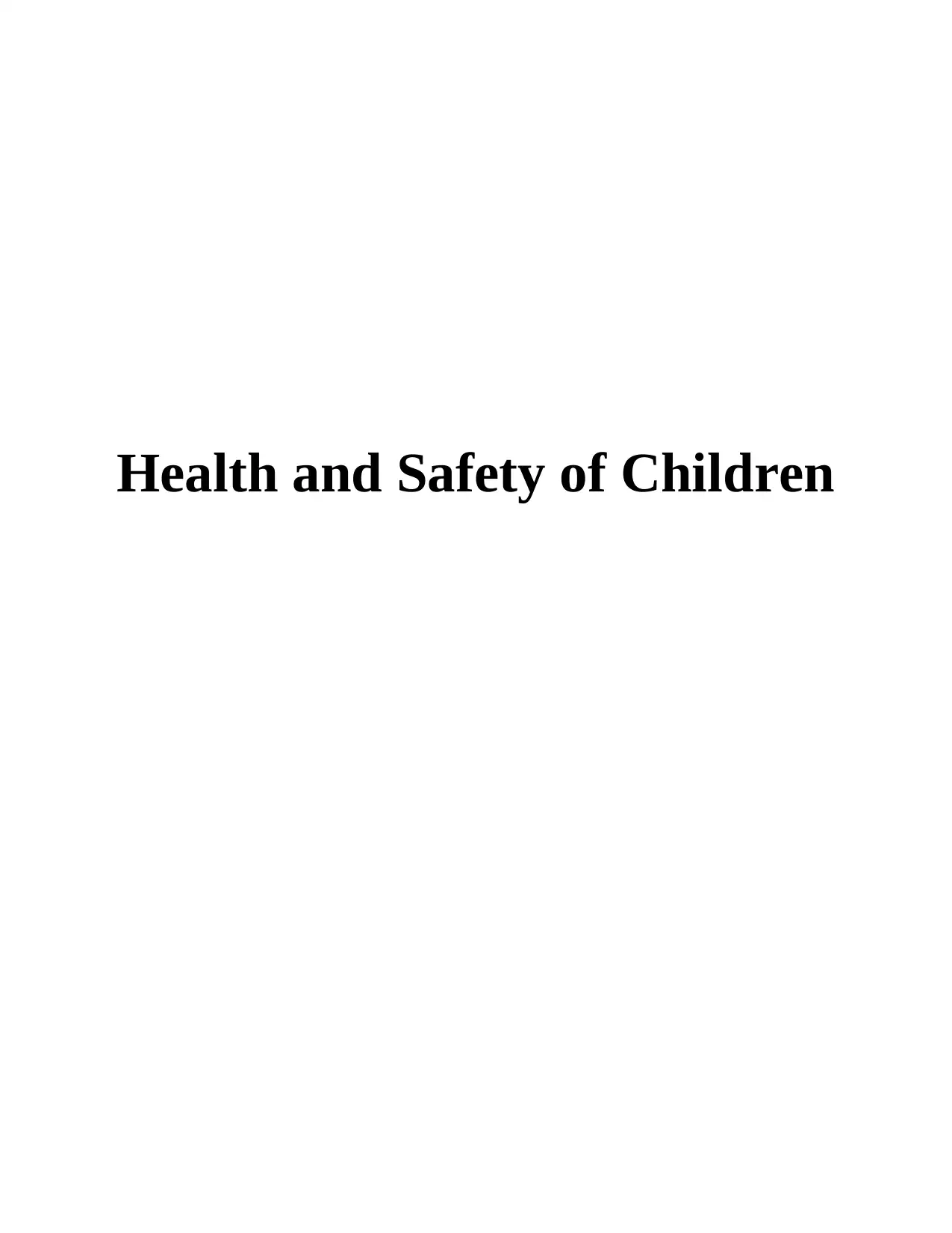
Health and Safety of Children
Paraphrase This Document
Need a fresh take? Get an instant paraphrase of this document with our AI Paraphraser

TABLE OF CONTENTS
INTRODUCTION:.........................................................................................................................1
ASSESSMENT 1.............................................................................................................................1
ASSESSMENT 2.............................................................................................................................6
CONCLUSION:.............................................................................................................................10
REFERENCES:.............................................................................................................................11
INTRODUCTION:.........................................................................................................................1
ASSESSMENT 1.............................................................................................................................1
ASSESSMENT 2.............................................................................................................................6
CONCLUSION:.............................................................................................................................10
REFERENCES:.............................................................................................................................11
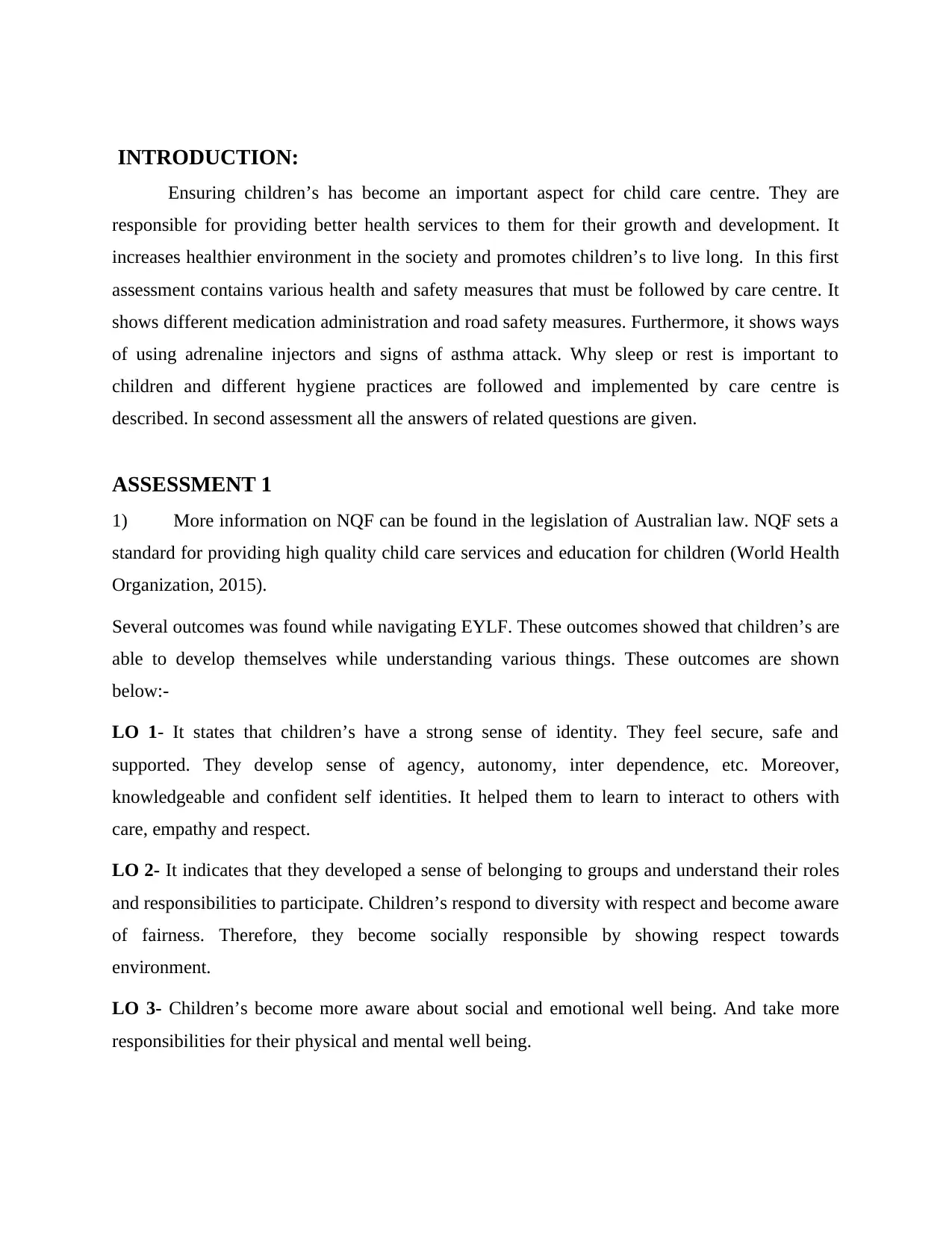
INTRODUCTION:
Ensuring children’s has become an important aspect for child care centre. They are
responsible for providing better health services to them for their growth and development. It
increases healthier environment in the society and promotes children’s to live long. In this first
assessment contains various health and safety measures that must be followed by care centre. It
shows different medication administration and road safety measures. Furthermore, it shows ways
of using adrenaline injectors and signs of asthma attack. Why sleep or rest is important to
children and different hygiene practices are followed and implemented by care centre is
described. In second assessment all the answers of related questions are given.
ASSESSMENT 1
1) More information on NQF can be found in the legislation of Australian law. NQF sets a
standard for providing high quality child care services and education for children (World Health
Organization, 2015).
Several outcomes was found while navigating EYLF. These outcomes showed that children’s are
able to develop themselves while understanding various things. These outcomes are shown
below:-
LO 1- It states that children’s have a strong sense of identity. They feel secure, safe and
supported. They develop sense of agency, autonomy, inter dependence, etc. Moreover,
knowledgeable and confident self identities. It helped them to learn to interact to others with
care, empathy and respect.
LO 2- It indicates that they developed a sense of belonging to groups and understand their roles
and responsibilities to participate. Children’s respond to diversity with respect and become aware
of fairness. Therefore, they become socially responsible by showing respect towards
environment.
LO 3- Children’s become more aware about social and emotional well being. And take more
responsibilities for their physical and mental well being.
Ensuring children’s has become an important aspect for child care centre. They are
responsible for providing better health services to them for their growth and development. It
increases healthier environment in the society and promotes children’s to live long. In this first
assessment contains various health and safety measures that must be followed by care centre. It
shows different medication administration and road safety measures. Furthermore, it shows ways
of using adrenaline injectors and signs of asthma attack. Why sleep or rest is important to
children and different hygiene practices are followed and implemented by care centre is
described. In second assessment all the answers of related questions are given.
ASSESSMENT 1
1) More information on NQF can be found in the legislation of Australian law. NQF sets a
standard for providing high quality child care services and education for children (World Health
Organization, 2015).
Several outcomes was found while navigating EYLF. These outcomes showed that children’s are
able to develop themselves while understanding various things. These outcomes are shown
below:-
LO 1- It states that children’s have a strong sense of identity. They feel secure, safe and
supported. They develop sense of agency, autonomy, inter dependence, etc. Moreover,
knowledgeable and confident self identities. It helped them to learn to interact to others with
care, empathy and respect.
LO 2- It indicates that they developed a sense of belonging to groups and understand their roles
and responsibilities to participate. Children’s respond to diversity with respect and become aware
of fairness. Therefore, they become socially responsible by showing respect towards
environment.
LO 3- Children’s become more aware about social and emotional well being. And take more
responsibilities for their physical and mental well being.
⊘ This is a preview!⊘
Do you want full access?
Subscribe today to unlock all pages.

Trusted by 1+ million students worldwide
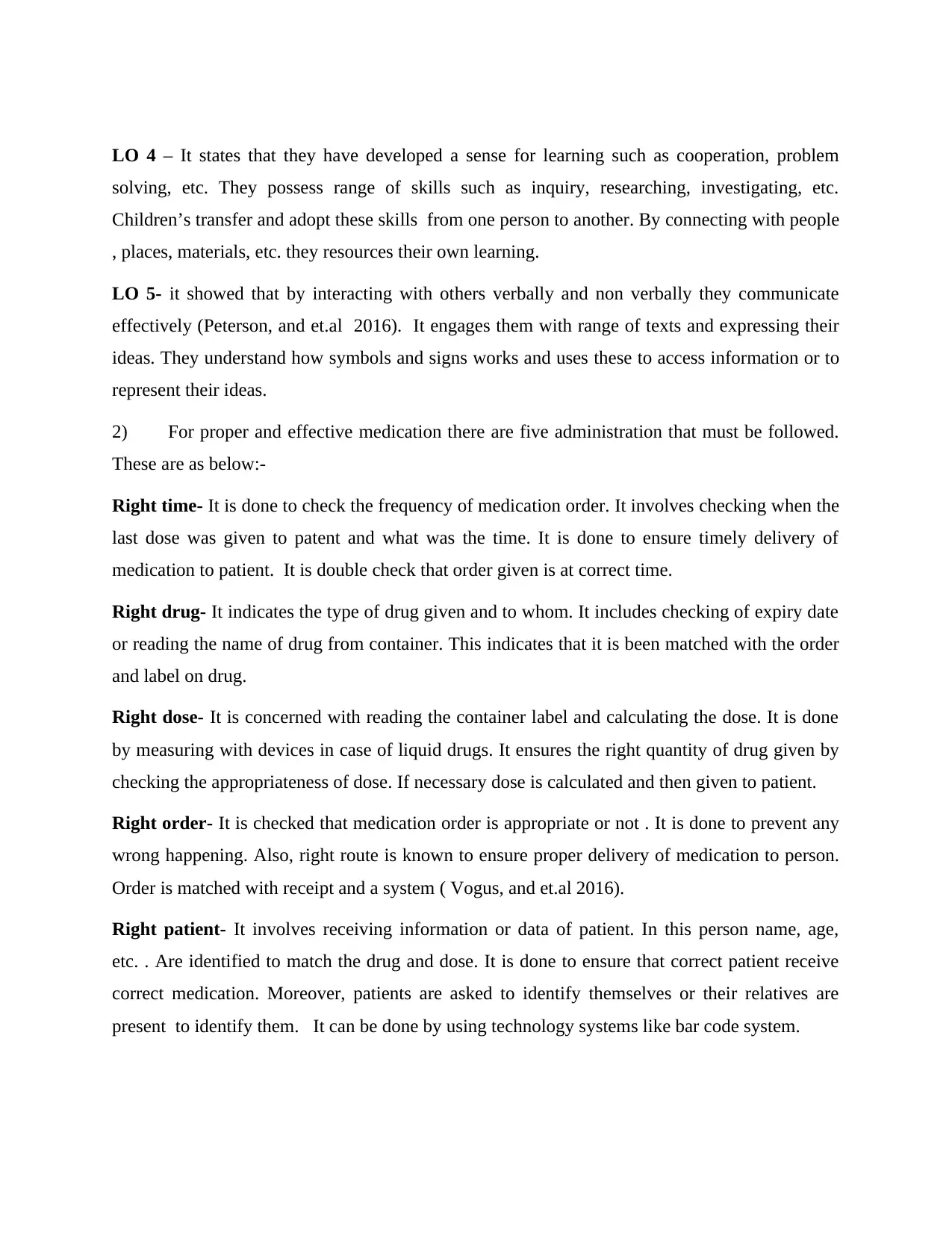
LO 4 – It states that they have developed a sense for learning such as cooperation, problem
solving, etc. They possess range of skills such as inquiry, researching, investigating, etc.
Children’s transfer and adopt these skills from one person to another. By connecting with people
, places, materials, etc. they resources their own learning.
LO 5- it showed that by interacting with others verbally and non verbally they communicate
effectively (Peterson, and et.al 2016). It engages them with range of texts and expressing their
ideas. They understand how symbols and signs works and uses these to access information or to
represent their ideas.
2) For proper and effective medication there are five administration that must be followed.
These are as below:-
Right time- It is done to check the frequency of medication order. It involves checking when the
last dose was given to patent and what was the time. It is done to ensure timely delivery of
medication to patient. It is double check that order given is at correct time.
Right drug- It indicates the type of drug given and to whom. It includes checking of expiry date
or reading the name of drug from container. This indicates that it is been matched with the order
and label on drug.
Right dose- It is concerned with reading the container label and calculating the dose. It is done
by measuring with devices in case of liquid drugs. It ensures the right quantity of drug given by
checking the appropriateness of dose. If necessary dose is calculated and then given to patient.
Right order- It is checked that medication order is appropriate or not . It is done to prevent any
wrong happening. Also, right route is known to ensure proper delivery of medication to person.
Order is matched with receipt and a system ( Vogus, and et.al 2016).
Right patient- It involves receiving information or data of patient. In this person name, age,
etc. . Are identified to match the drug and dose. It is done to ensure that correct patient receive
correct medication. Moreover, patients are asked to identify themselves or their relatives are
present to identify them. It can be done by using technology systems like bar code system.
solving, etc. They possess range of skills such as inquiry, researching, investigating, etc.
Children’s transfer and adopt these skills from one person to another. By connecting with people
, places, materials, etc. they resources their own learning.
LO 5- it showed that by interacting with others verbally and non verbally they communicate
effectively (Peterson, and et.al 2016). It engages them with range of texts and expressing their
ideas. They understand how symbols and signs works and uses these to access information or to
represent their ideas.
2) For proper and effective medication there are five administration that must be followed.
These are as below:-
Right time- It is done to check the frequency of medication order. It involves checking when the
last dose was given to patent and what was the time. It is done to ensure timely delivery of
medication to patient. It is double check that order given is at correct time.
Right drug- It indicates the type of drug given and to whom. It includes checking of expiry date
or reading the name of drug from container. This indicates that it is been matched with the order
and label on drug.
Right dose- It is concerned with reading the container label and calculating the dose. It is done
by measuring with devices in case of liquid drugs. It ensures the right quantity of drug given by
checking the appropriateness of dose. If necessary dose is calculated and then given to patient.
Right order- It is checked that medication order is appropriate or not . It is done to prevent any
wrong happening. Also, right route is known to ensure proper delivery of medication to person.
Order is matched with receipt and a system ( Vogus, and et.al 2016).
Right patient- It involves receiving information or data of patient. In this person name, age,
etc. . Are identified to match the drug and dose. It is done to ensure that correct patient receive
correct medication. Moreover, patients are asked to identify themselves or their relatives are
present to identify them. It can be done by using technology systems like bar code system.
Paraphrase This Document
Need a fresh take? Get an instant paraphrase of this document with our AI Paraphraser

3) It is necessary to provide basic information regarding the road safety measures to
children’s. It will b useful for them to follow when they walk on roads. These measures must be
taught in simple language or by giving practical presentation to them. There are many road
safety measures that are followed:-
Firstly, they should know about the three different light colours and its use. Red means
to stop, yellow means to wait and green means go. This will give them an insight about
basic traffic light meaning (Olympia, and et.al 2015).
Before crossing road carefully watch your right and left side to make sure that no vehicle
is coming.
Always hold your parents hand while walking or crossing the road.
Do not run in excitement to other side in order to meet someone .
Always wear a helmet while riding a bicycle and check certain important parts like
brakes, handle, etc. before riding to prevent it from any accident.
Always use side paths to walk to stay safe on the roads whether it is busy street or not
Never stick your hand or head outside in a school bus or car. It can cause harm to you.
Carefully playing in parks that are near roads. Also, not rushing out quickly to cross the
road.
4) Toddlers are children’s that are below age of 5 years. They are kept in care centre to
grow and develop their physical and mental health. It is required that some basic furniture is
required in toddler to climb, play for children. Along with this some toys and materials can also
be added.
Blocks- they are made up from foam or cardboard blocks, it also includes plastic animals
and cars that is perfect for children’s (Duffy, and et.al, 2017).
Sensory- it includes table that contains various items like sand, water that helps in
developing sensory feeling to children by touching, smelling, etc.
children’s. It will b useful for them to follow when they walk on roads. These measures must be
taught in simple language or by giving practical presentation to them. There are many road
safety measures that are followed:-
Firstly, they should know about the three different light colours and its use. Red means
to stop, yellow means to wait and green means go. This will give them an insight about
basic traffic light meaning (Olympia, and et.al 2015).
Before crossing road carefully watch your right and left side to make sure that no vehicle
is coming.
Always hold your parents hand while walking or crossing the road.
Do not run in excitement to other side in order to meet someone .
Always wear a helmet while riding a bicycle and check certain important parts like
brakes, handle, etc. before riding to prevent it from any accident.
Always use side paths to walk to stay safe on the roads whether it is busy street or not
Never stick your hand or head outside in a school bus or car. It can cause harm to you.
Carefully playing in parks that are near roads. Also, not rushing out quickly to cross the
road.
4) Toddlers are children’s that are below age of 5 years. They are kept in care centre to
grow and develop their physical and mental health. It is required that some basic furniture is
required in toddler to climb, play for children. Along with this some toys and materials can also
be added.
Blocks- they are made up from foam or cardboard blocks, it also includes plastic animals
and cars that is perfect for children’s (Duffy, and et.al, 2017).
Sensory- it includes table that contains various items like sand, water that helps in
developing sensory feeling to children by touching, smelling, etc.
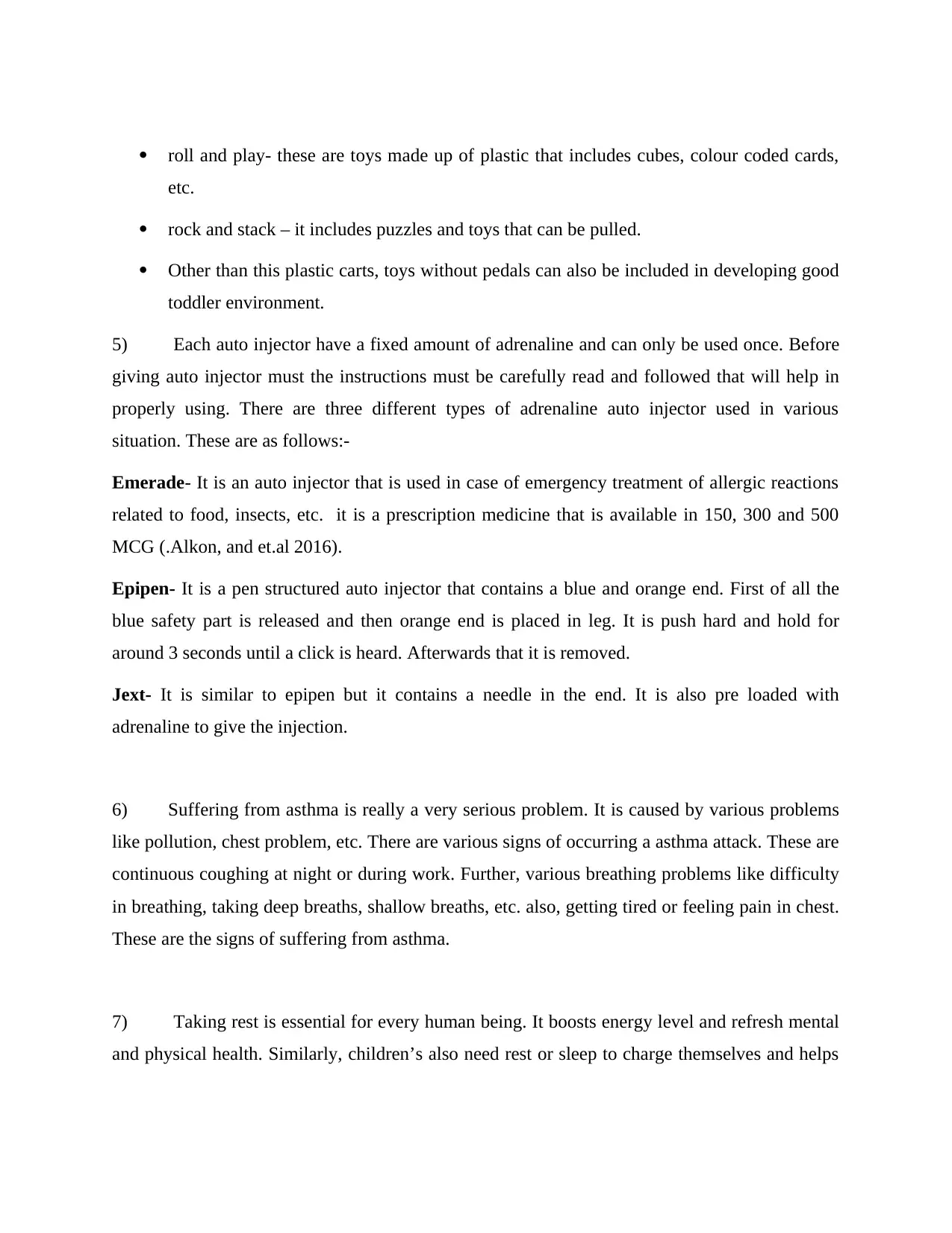
roll and play- these are toys made up of plastic that includes cubes, colour coded cards,
etc.
rock and stack – it includes puzzles and toys that can be pulled.
Other than this plastic carts, toys without pedals can also be included in developing good
toddler environment.
5) Each auto injector have a fixed amount of adrenaline and can only be used once. Before
giving auto injector must the instructions must be carefully read and followed that will help in
properly using. There are three different types of adrenaline auto injector used in various
situation. These are as follows:-
Emerade- It is an auto injector that is used in case of emergency treatment of allergic reactions
related to food, insects, etc. it is a prescription medicine that is available in 150, 300 and 500
MCG (.Alkon, and et.al 2016).
Epipen- It is a pen structured auto injector that contains a blue and orange end. First of all the
blue safety part is released and then orange end is placed in leg. It is push hard and hold for
around 3 seconds until a click is heard. Afterwards that it is removed.
Jext- It is similar to epipen but it contains a needle in the end. It is also pre loaded with
adrenaline to give the injection.
6) Suffering from asthma is really a very serious problem. It is caused by various problems
like pollution, chest problem, etc. There are various signs of occurring a asthma attack. These are
continuous coughing at night or during work. Further, various breathing problems like difficulty
in breathing, taking deep breaths, shallow breaths, etc. also, getting tired or feeling pain in chest.
These are the signs of suffering from asthma.
7) Taking rest is essential for every human being. It boosts energy level and refresh mental
and physical health. Similarly, children’s also need rest or sleep to charge themselves and helps
etc.
rock and stack – it includes puzzles and toys that can be pulled.
Other than this plastic carts, toys without pedals can also be included in developing good
toddler environment.
5) Each auto injector have a fixed amount of adrenaline and can only be used once. Before
giving auto injector must the instructions must be carefully read and followed that will help in
properly using. There are three different types of adrenaline auto injector used in various
situation. These are as follows:-
Emerade- It is an auto injector that is used in case of emergency treatment of allergic reactions
related to food, insects, etc. it is a prescription medicine that is available in 150, 300 and 500
MCG (.Alkon, and et.al 2016).
Epipen- It is a pen structured auto injector that contains a blue and orange end. First of all the
blue safety part is released and then orange end is placed in leg. It is push hard and hold for
around 3 seconds until a click is heard. Afterwards that it is removed.
Jext- It is similar to epipen but it contains a needle in the end. It is also pre loaded with
adrenaline to give the injection.
6) Suffering from asthma is really a very serious problem. It is caused by various problems
like pollution, chest problem, etc. There are various signs of occurring a asthma attack. These are
continuous coughing at night or during work. Further, various breathing problems like difficulty
in breathing, taking deep breaths, shallow breaths, etc. also, getting tired or feeling pain in chest.
These are the signs of suffering from asthma.
7) Taking rest is essential for every human being. It boosts energy level and refresh mental
and physical health. Similarly, children’s also need rest or sleep to charge themselves and helps
⊘ This is a preview!⊘
Do you want full access?
Subscribe today to unlock all pages.

Trusted by 1+ million students worldwide

in their growth. A small nap can restore the energy in them and it helps in grasping things
quickly and easily. Also, it gives rest to all body parts including heart and brain. After sleeping it
increases their attention level and boosts their learning skills. Moreover, it reduces chances of
getting ill and improves their overall physical health. It ensures physical and mental well being
of children for long term.
8) NQS focuses on promoting children’s health and safety. It ensures that care centre
provides and follow effective hygiene practices. It means that children’s must be prevented from
health issues by creating a healthy environment (Mills,., 2016). For this various elements has
been made that gives s platform for care centres to follow this.:-
The first element is each child health is supported by identifying its needs. Each child comfort is
provided and there are appropriate opportunities for meeting their rest, sleep, etc. Moreover,
effective hygiene practices must be promoted and implemented. Steps must be taken to control
infectious diseases by following guidelines.
Second one is meals provided must be healthy and nutritious to each child. Also, physical
activities are promoted with child experience.
Third one is each child is protected by supervision. Each child must be protected from harm and
plans should be develop to overcome any critical emergency situations. Staff members should
know their roles and responsibilities to respond to every child.
High quality hygiene practices helps in preventing spread of infectious disease in centre. It
reduces risk of children’s from getting ill by cross infection of germs and bacteria. Best practices
must be implemented by consulting with health authorities. A storage system must be made to
safely keep foods brought by children’s from home (Scalabrin, and et.al, 2017).
Hand washing practices must be followed in centre so that children’s must wash their hands with
sanitizer before and after having food. They must be taught about dental care I.e brushing their
teeth twice a day. Moreover, how to maintain care of ears by cleaning it after taking bath. These
hygiene practices should be promoted and implemented in care centre.
quickly and easily. Also, it gives rest to all body parts including heart and brain. After sleeping it
increases their attention level and boosts their learning skills. Moreover, it reduces chances of
getting ill and improves their overall physical health. It ensures physical and mental well being
of children for long term.
8) NQS focuses on promoting children’s health and safety. It ensures that care centre
provides and follow effective hygiene practices. It means that children’s must be prevented from
health issues by creating a healthy environment (Mills,., 2016). For this various elements has
been made that gives s platform for care centres to follow this.:-
The first element is each child health is supported by identifying its needs. Each child comfort is
provided and there are appropriate opportunities for meeting their rest, sleep, etc. Moreover,
effective hygiene practices must be promoted and implemented. Steps must be taken to control
infectious diseases by following guidelines.
Second one is meals provided must be healthy and nutritious to each child. Also, physical
activities are promoted with child experience.
Third one is each child is protected by supervision. Each child must be protected from harm and
plans should be develop to overcome any critical emergency situations. Staff members should
know their roles and responsibilities to respond to every child.
High quality hygiene practices helps in preventing spread of infectious disease in centre. It
reduces risk of children’s from getting ill by cross infection of germs and bacteria. Best practices
must be implemented by consulting with health authorities. A storage system must be made to
safely keep foods brought by children’s from home (Scalabrin, and et.al, 2017).
Hand washing practices must be followed in centre so that children’s must wash their hands with
sanitizer before and after having food. They must be taught about dental care I.e brushing their
teeth twice a day. Moreover, how to maintain care of ears by cleaning it after taking bath. These
hygiene practices should be promoted and implemented in care centre.
Paraphrase This Document
Need a fresh take? Get an instant paraphrase of this document with our AI Paraphraser

ASSESSMENT 2
1) There are various practices that are provided in child care centre. These practices ensure
the safety of children’s and provides them a healthy environment. Various services provided
are:-
Regularly washing of hands with sanitizer before and after having food. It promotes healthy and
safe eating of food practices. Children’s are also advice to wash hands regularly after playing
games so that there is no cross inter section of germs and bacteria from one child to another.
Moreover, the surface is washed every day with sanitizer t provide germs free environment for
children to play. Also, wash rooms and toilets are regularly washed and cleaned by staff that
adds to hygiene practices (World Health Organization WHO, 2017).
Proper and healthy snacks are provided to children’s to give them some energy. Apart from this
the children that are very dirty are given a bath.
2) In addition to hygiene practices various safety measures are also followed that ensures
proper safety environment in the centre. It is done by implementing different methods and
policies that are made and followed. Various safety measures are:
A proper automatic fire safety system is implemented that will be useful in fire situations. Also,
good and comfortable furniture is installed that will allow children to play. Moreover, proper
fencing is done all around the play area so that no child goes out of centre. A security guard
regularly watches the entire processing of incoming and outgoing of children with parents.
Systematic entries are done that records entry and exit timings of parents. CCTV cameras are
installed in every place to have a watch on every children that are in centre. A separate room is
made where basic medical facilities are there that can be given in emergency treatment of child.
1) There are various practices that are provided in child care centre. These practices ensure
the safety of children’s and provides them a healthy environment. Various services provided
are:-
Regularly washing of hands with sanitizer before and after having food. It promotes healthy and
safe eating of food practices. Children’s are also advice to wash hands regularly after playing
games so that there is no cross inter section of germs and bacteria from one child to another.
Moreover, the surface is washed every day with sanitizer t provide germs free environment for
children to play. Also, wash rooms and toilets are regularly washed and cleaned by staff that
adds to hygiene practices (World Health Organization WHO, 2017).
Proper and healthy snacks are provided to children’s to give them some energy. Apart from this
the children that are very dirty are given a bath.
2) In addition to hygiene practices various safety measures are also followed that ensures
proper safety environment in the centre. It is done by implementing different methods and
policies that are made and followed. Various safety measures are:
A proper automatic fire safety system is implemented that will be useful in fire situations. Also,
good and comfortable furniture is installed that will allow children to play. Moreover, proper
fencing is done all around the play area so that no child goes out of centre. A security guard
regularly watches the entire processing of incoming and outgoing of children with parents.
Systematic entries are done that records entry and exit timings of parents. CCTV cameras are
installed in every place to have a watch on every children that are in centre. A separate room is
made where basic medical facilities are there that can be given in emergency treatment of child.
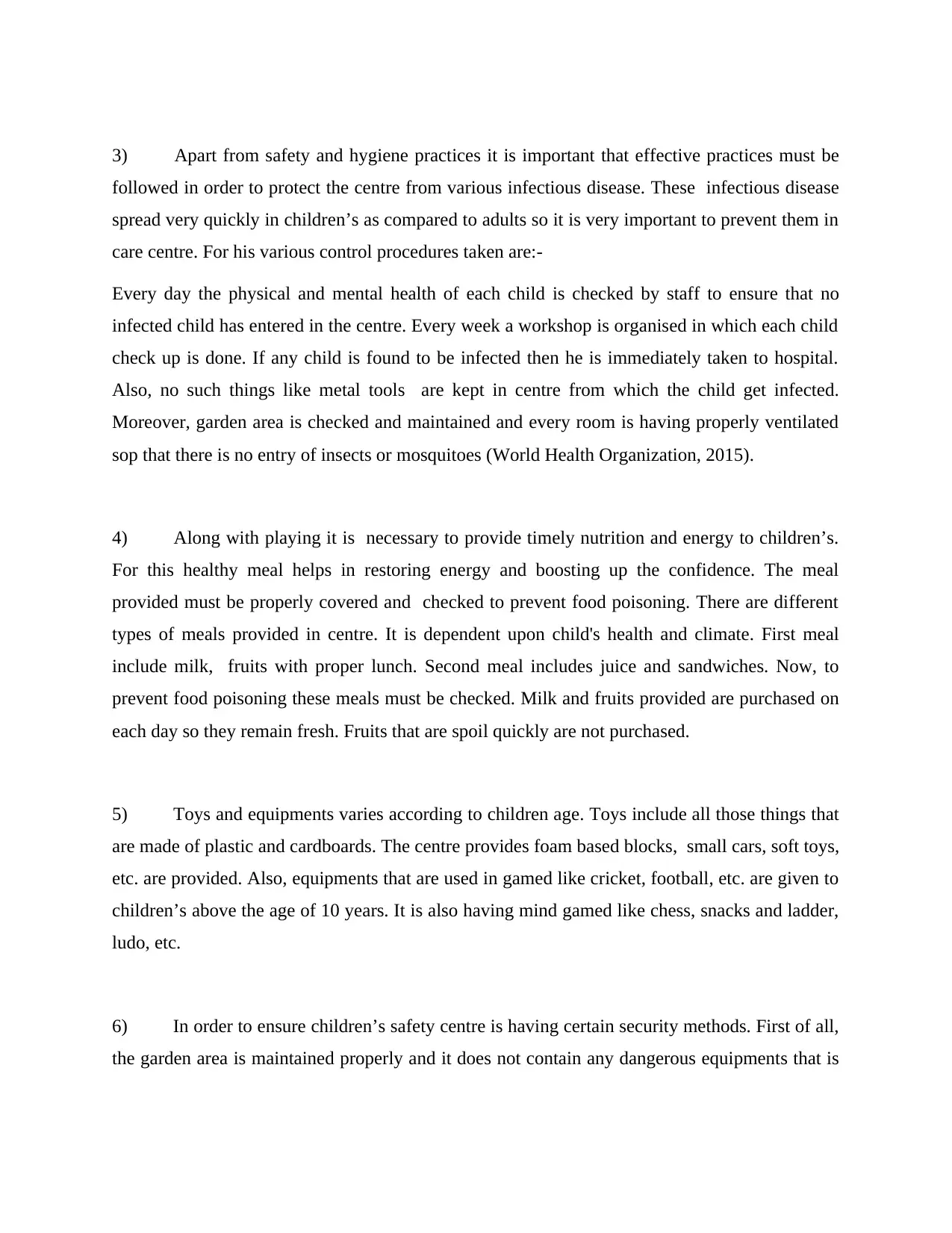
3) Apart from safety and hygiene practices it is important that effective practices must be
followed in order to protect the centre from various infectious disease. These infectious disease
spread very quickly in children’s as compared to adults so it is very important to prevent them in
care centre. For his various control procedures taken are:-
Every day the physical and mental health of each child is checked by staff to ensure that no
infected child has entered in the centre. Every week a workshop is organised in which each child
check up is done. If any child is found to be infected then he is immediately taken to hospital.
Also, no such things like metal tools are kept in centre from which the child get infected.
Moreover, garden area is checked and maintained and every room is having properly ventilated
sop that there is no entry of insects or mosquitoes (World Health Organization, 2015).
4) Along with playing it is necessary to provide timely nutrition and energy to children’s.
For this healthy meal helps in restoring energy and boosting up the confidence. The meal
provided must be properly covered and checked to prevent food poisoning. There are different
types of meals provided in centre. It is dependent upon child's health and climate. First meal
include milk, fruits with proper lunch. Second meal includes juice and sandwiches. Now, to
prevent food poisoning these meals must be checked. Milk and fruits provided are purchased on
each day so they remain fresh. Fruits that are spoil quickly are not purchased.
5) Toys and equipments varies according to children age. Toys include all those things that
are made of plastic and cardboards. The centre provides foam based blocks, small cars, soft toys,
etc. are provided. Also, equipments that are used in gamed like cricket, football, etc. are given to
children’s above the age of 10 years. It is also having mind gamed like chess, snacks and ladder,
ludo, etc.
6) In order to ensure children’s safety centre is having certain security methods. First of all,
the garden area is maintained properly and it does not contain any dangerous equipments that is
followed in order to protect the centre from various infectious disease. These infectious disease
spread very quickly in children’s as compared to adults so it is very important to prevent them in
care centre. For his various control procedures taken are:-
Every day the physical and mental health of each child is checked by staff to ensure that no
infected child has entered in the centre. Every week a workshop is organised in which each child
check up is done. If any child is found to be infected then he is immediately taken to hospital.
Also, no such things like metal tools are kept in centre from which the child get infected.
Moreover, garden area is checked and maintained and every room is having properly ventilated
sop that there is no entry of insects or mosquitoes (World Health Organization, 2015).
4) Along with playing it is necessary to provide timely nutrition and energy to children’s.
For this healthy meal helps in restoring energy and boosting up the confidence. The meal
provided must be properly covered and checked to prevent food poisoning. There are different
types of meals provided in centre. It is dependent upon child's health and climate. First meal
include milk, fruits with proper lunch. Second meal includes juice and sandwiches. Now, to
prevent food poisoning these meals must be checked. Milk and fruits provided are purchased on
each day so they remain fresh. Fruits that are spoil quickly are not purchased.
5) Toys and equipments varies according to children age. Toys include all those things that
are made of plastic and cardboards. The centre provides foam based blocks, small cars, soft toys,
etc. are provided. Also, equipments that are used in gamed like cricket, football, etc. are given to
children’s above the age of 10 years. It is also having mind gamed like chess, snacks and ladder,
ludo, etc.
6) In order to ensure children’s safety centre is having certain security methods. First of all,
the garden area is maintained properly and it does not contain any dangerous equipments that is
⊘ This is a preview!⊘
Do you want full access?
Subscribe today to unlock all pages.

Trusted by 1+ million students worldwide
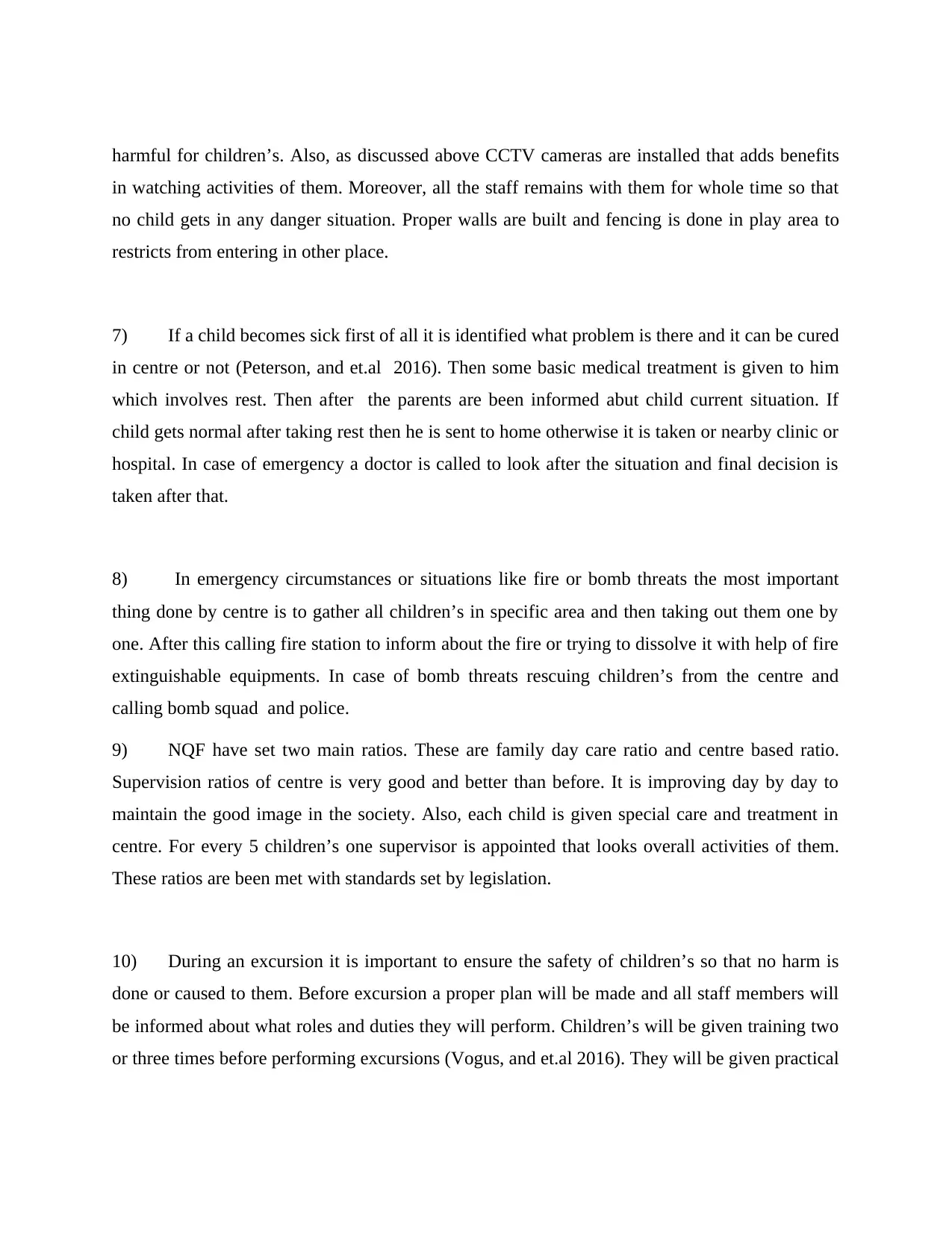
harmful for children’s. Also, as discussed above CCTV cameras are installed that adds benefits
in watching activities of them. Moreover, all the staff remains with them for whole time so that
no child gets in any danger situation. Proper walls are built and fencing is done in play area to
restricts from entering in other place.
7) If a child becomes sick first of all it is identified what problem is there and it can be cured
in centre or not (Peterson, and et.al 2016). Then some basic medical treatment is given to him
which involves rest. Then after the parents are been informed abut child current situation. If
child gets normal after taking rest then he is sent to home otherwise it is taken or nearby clinic or
hospital. In case of emergency a doctor is called to look after the situation and final decision is
taken after that.
8) In emergency circumstances or situations like fire or bomb threats the most important
thing done by centre is to gather all children’s in specific area and then taking out them one by
one. After this calling fire station to inform about the fire or trying to dissolve it with help of fire
extinguishable equipments. In case of bomb threats rescuing children’s from the centre and
calling bomb squad and police.
9) NQF have set two main ratios. These are family day care ratio and centre based ratio.
Supervision ratios of centre is very good and better than before. It is improving day by day to
maintain the good image in the society. Also, each child is given special care and treatment in
centre. For every 5 children’s one supervisor is appointed that looks overall activities of them.
These ratios are been met with standards set by legislation.
10) During an excursion it is important to ensure the safety of children’s so that no harm is
done or caused to them. Before excursion a proper plan will be made and all staff members will
be informed about what roles and duties they will perform. Children’s will be given training two
or three times before performing excursions (Vogus, and et.al 2016). They will be given practical
in watching activities of them. Moreover, all the staff remains with them for whole time so that
no child gets in any danger situation. Proper walls are built and fencing is done in play area to
restricts from entering in other place.
7) If a child becomes sick first of all it is identified what problem is there and it can be cured
in centre or not (Peterson, and et.al 2016). Then some basic medical treatment is given to him
which involves rest. Then after the parents are been informed abut child current situation. If
child gets normal after taking rest then he is sent to home otherwise it is taken or nearby clinic or
hospital. In case of emergency a doctor is called to look after the situation and final decision is
taken after that.
8) In emergency circumstances or situations like fire or bomb threats the most important
thing done by centre is to gather all children’s in specific area and then taking out them one by
one. After this calling fire station to inform about the fire or trying to dissolve it with help of fire
extinguishable equipments. In case of bomb threats rescuing children’s from the centre and
calling bomb squad and police.
9) NQF have set two main ratios. These are family day care ratio and centre based ratio.
Supervision ratios of centre is very good and better than before. It is improving day by day to
maintain the good image in the society. Also, each child is given special care and treatment in
centre. For every 5 children’s one supervisor is appointed that looks overall activities of them.
These ratios are been met with standards set by legislation.
10) During an excursion it is important to ensure the safety of children’s so that no harm is
done or caused to them. Before excursion a proper plan will be made and all staff members will
be informed about what roles and duties they will perform. Children’s will be given training two
or three times before performing excursions (Vogus, and et.al 2016). They will be given practical
Paraphrase This Document
Need a fresh take? Get an instant paraphrase of this document with our AI Paraphraser
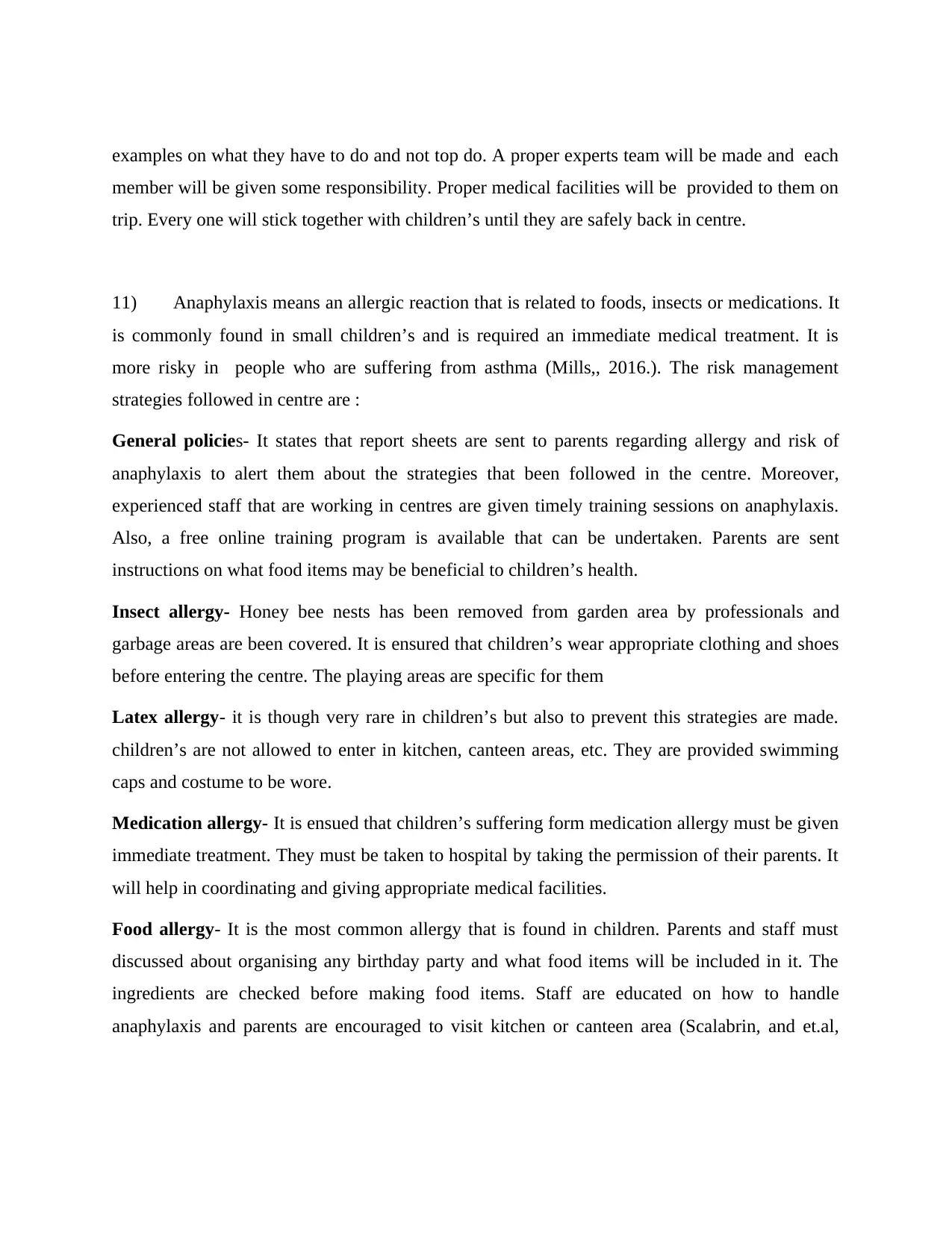
examples on what they have to do and not top do. A proper experts team will be made and each
member will be given some responsibility. Proper medical facilities will be provided to them on
trip. Every one will stick together with children’s until they are safely back in centre.
11) Anaphylaxis means an allergic reaction that is related to foods, insects or medications. It
is commonly found in small children’s and is required an immediate medical treatment. It is
more risky in people who are suffering from asthma (Mills,, 2016.). The risk management
strategies followed in centre are :
General policies- It states that report sheets are sent to parents regarding allergy and risk of
anaphylaxis to alert them about the strategies that been followed in the centre. Moreover,
experienced staff that are working in centres are given timely training sessions on anaphylaxis.
Also, a free online training program is available that can be undertaken. Parents are sent
instructions on what food items may be beneficial to children’s health.
Insect allergy- Honey bee nests has been removed from garden area by professionals and
garbage areas are been covered. It is ensured that children’s wear appropriate clothing and shoes
before entering the centre. The playing areas are specific for them
Latex allergy- it is though very rare in children’s but also to prevent this strategies are made.
children’s are not allowed to enter in kitchen, canteen areas, etc. They are provided swimming
caps and costume to be wore.
Medication allergy- It is ensued that children’s suffering form medication allergy must be given
immediate treatment. They must be taken to hospital by taking the permission of their parents. It
will help in coordinating and giving appropriate medical facilities.
Food allergy- It is the most common allergy that is found in children. Parents and staff must
discussed about organising any birthday party and what food items will be included in it. The
ingredients are checked before making food items. Staff are educated on how to handle
anaphylaxis and parents are encouraged to visit kitchen or canteen area (Scalabrin, and et.al,
member will be given some responsibility. Proper medical facilities will be provided to them on
trip. Every one will stick together with children’s until they are safely back in centre.
11) Anaphylaxis means an allergic reaction that is related to foods, insects or medications. It
is commonly found in small children’s and is required an immediate medical treatment. It is
more risky in people who are suffering from asthma (Mills,, 2016.). The risk management
strategies followed in centre are :
General policies- It states that report sheets are sent to parents regarding allergy and risk of
anaphylaxis to alert them about the strategies that been followed in the centre. Moreover,
experienced staff that are working in centres are given timely training sessions on anaphylaxis.
Also, a free online training program is available that can be undertaken. Parents are sent
instructions on what food items may be beneficial to children’s health.
Insect allergy- Honey bee nests has been removed from garden area by professionals and
garbage areas are been covered. It is ensured that children’s wear appropriate clothing and shoes
before entering the centre. The playing areas are specific for them
Latex allergy- it is though very rare in children’s but also to prevent this strategies are made.
children’s are not allowed to enter in kitchen, canteen areas, etc. They are provided swimming
caps and costume to be wore.
Medication allergy- It is ensued that children’s suffering form medication allergy must be given
immediate treatment. They must be taken to hospital by taking the permission of their parents. It
will help in coordinating and giving appropriate medical facilities.
Food allergy- It is the most common allergy that is found in children. Parents and staff must
discussed about organising any birthday party and what food items will be included in it. The
ingredients are checked before making food items. Staff are educated on how to handle
anaphylaxis and parents are encouraged to visit kitchen or canteen area (Scalabrin, and et.al,
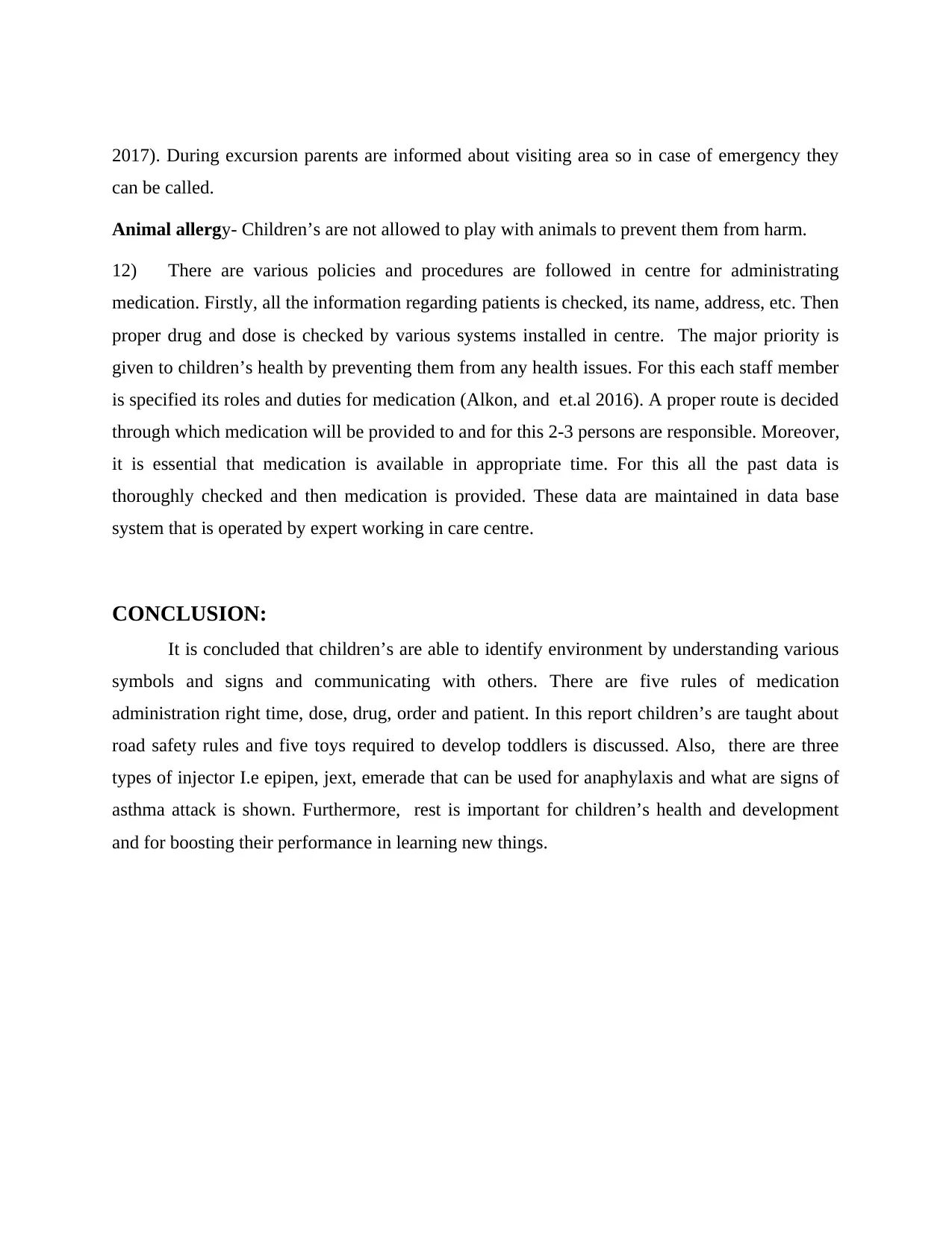
2017). During excursion parents are informed about visiting area so in case of emergency they
can be called.
Animal allergy- Children’s are not allowed to play with animals to prevent them from harm.
12) There are various policies and procedures are followed in centre for administrating
medication. Firstly, all the information regarding patients is checked, its name, address, etc. Then
proper drug and dose is checked by various systems installed in centre. The major priority is
given to children’s health by preventing them from any health issues. For this each staff member
is specified its roles and duties for medication (Alkon, and et.al 2016). A proper route is decided
through which medication will be provided to and for this 2-3 persons are responsible. Moreover,
it is essential that medication is available in appropriate time. For this all the past data is
thoroughly checked and then medication is provided. These data are maintained in data base
system that is operated by expert working in care centre.
CONCLUSION:
It is concluded that children’s are able to identify environment by understanding various
symbols and signs and communicating with others. There are five rules of medication
administration right time, dose, drug, order and patient. In this report children’s are taught about
road safety rules and five toys required to develop toddlers is discussed. Also, there are three
types of injector I.e epipen, jext, emerade that can be used for anaphylaxis and what are signs of
asthma attack is shown. Furthermore, rest is important for children’s health and development
and for boosting their performance in learning new things.
can be called.
Animal allergy- Children’s are not allowed to play with animals to prevent them from harm.
12) There are various policies and procedures are followed in centre for administrating
medication. Firstly, all the information regarding patients is checked, its name, address, etc. Then
proper drug and dose is checked by various systems installed in centre. The major priority is
given to children’s health by preventing them from any health issues. For this each staff member
is specified its roles and duties for medication (Alkon, and et.al 2016). A proper route is decided
through which medication will be provided to and for this 2-3 persons are responsible. Moreover,
it is essential that medication is available in appropriate time. For this all the past data is
thoroughly checked and then medication is provided. These data are maintained in data base
system that is operated by expert working in care centre.
CONCLUSION:
It is concluded that children’s are able to identify environment by understanding various
symbols and signs and communicating with others. There are five rules of medication
administration right time, dose, drug, order and patient. In this report children’s are taught about
road safety rules and five toys required to develop toddlers is discussed. Also, there are three
types of injector I.e epipen, jext, emerade that can be used for anaphylaxis and what are signs of
asthma attack is shown. Furthermore, rest is important for children’s health and development
and for boosting their performance in learning new things.
⊘ This is a preview!⊘
Do you want full access?
Subscribe today to unlock all pages.

Trusted by 1+ million students worldwide
1 out of 13
Related Documents
Your All-in-One AI-Powered Toolkit for Academic Success.
+13062052269
info@desklib.com
Available 24*7 on WhatsApp / Email
![[object Object]](/_next/static/media/star-bottom.7253800d.svg)
Unlock your academic potential
Copyright © 2020–2025 A2Z Services. All Rights Reserved. Developed and managed by ZUCOL.





